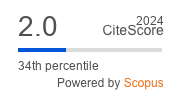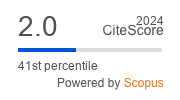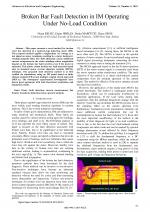| 4/2016 - 10 |
Broken Bar Fault Detection in IM Operating Under No-Load ConditionRELJIC, D. |
| Extra paper information in |
| Click to see author's profile in |
| Download PDF |
Author keywords
fault detection, current measurement, fast Fourier transform, induction motor, spectral analysis
References keywords
induction(17), rotor(14), motors(12), analysis(10), diagnosis(9), industry(7), detection(7), machines(6), fault(6), energy(6)
Blue keywords are present in both the references section and the paper title.
About this article
Date of Publication: 2016-11-30
Volume 16, Issue 4, Year 2016, On page(s): 63 - 70
ISSN: 1582-7445, e-ISSN: 1844-7600
Digital Object Identifier: 10.4316/AECE.2016.04010
Web of Science Accession Number: 000390675900010
SCOPUS ID: 85007559647
Abstract
This paper presents a novel method for broken rotor bar detection in a squirrel-cage induction motor (IM). The proposed method applies a single-phase AC voltage as a test signal on motor terminals, resulting in a stator backward-rotating magnetic field. The field ultimately causes additional current components in the stator windings whose magnitudes depend on the broken bar fault severity, even if the motor is unloaded. This allows robust broken bar fault detection based only on standard motor current signature analysis (MCSA) technique. The proposed fault detection method is at first verified via simulations, using an IM model based on finite element analysis (FEA) and multiple coupled circuit approach (MCCA). The subsequent experimental investigations have shown good agreement with both theoretical predictions and simulation results. |
| References | | | Cited By «-- Click to see who has cited this paper |
| [1] A. H. Bonnett, "Root Cause AC Motor Failure Analysis with a Focus on Shaft Failures," IEEE Transactions on Industry Applications, vol. 36, no. 5, pp. 1435-1448, Sep/Oct 2000. [CrossRef] [SCOPUS Times Cited 106] [2] A. H. Bonnett, "Root cause failure analysis for AC Induction Motors in the petroleum and chemical industry," in Proc. 57th Annu. Petroleum and Chemical Industry Conference, San Antonio, 2010, pp. 1-13. [CrossRef] [SCOPUS Times Cited 17] [3] O. V. Thorsen, M. Dalva, "A survey of Faults on Induction Motors in Offshore Oil Industry, Petrochemical Industry, Gas Terminals, and Oil Refineries," IEEE Transactions on Industry Applications, vol. 31, no. 5, pp. 1186-1196, Sep./Oct. 1995. [CrossRef] [SCOPUS Times Cited 366] [4] G. B. Kliman, R. A. Koegl, J. Stein, R. D. Endicott, and M. W. Madden, "Noninvasive detection of broken rotor bars in operating induction motors," IEEE Trans. Energy Convers., vol. 3, no. 4, pp. 873-879, Dec. 1988. [CrossRef] [SCOPUS Times Cited 443] [5] M. E. H. Benbouzid, "A review of induction motors signature analysis as a medium for faults detection," IEEE Transactions on Industrial Electronics, vol. 47 no. 5, pp. 984-993, Oct. 2000. [CrossRef] [SCOPUS Times Cited 1420] [6] S. Nandi, H. A. Toliyat, and X. Li, "Condition monitoring and fault diagnosis of electrical motors-a review," IEEE Trans. Energy Convers., vol. 20, no. 4, pp. 719-729, Dec. 2005. [CrossRef] [SCOPUS Times Cited 2083] [7] L. Mihet-Popa, "Current Signature Analysis as Diagnosis Media for Incipient Fault Detection," Advances in Electrical and Computer Engineering, vol. 7, no. 2, pp. 11-15, November 2007. [CrossRef] [Full Text] [8] G. Didier, E. Ternisien, O. Caspary, and H. Razik, "A new approach to detect broken rotor bars in induction machines by current spectrum analysis," Mech. Syst. Signal Process., vol. 21, no. 2, pp. 1127-1142, Feb. 2007. [CrossRef] [SCOPUS Times Cited 100] [9] K. N. Gyftakis and J. C. Kappatou, "The Zero-Sequence Current as a Generalized Diagnostic Mean in Delta-Connected Three-Phase Induction Motors," IEEE Trans. Energy Convers., vol. 29, no. 1, pp. 138-148, Mar. 2014. [CrossRef] [SCOPUS Times Cited 74] [10] S. Shin, J. Kim, S. B. Lee, C. Lim, and E. J. Wiedenbrug, "Evaluation of the Influence of Rotor Magnetic Anisotropy on Condition Monitoring of Two-Pole Induction Motors," IEEE Transactions on Industry Applications , vol. 51, no. 4, pp. 2896-2904, July 2015. [CrossRef] [SCOPUS Times Cited 35] [11] A. Ceban, R. Pusca, and R. Romary, "Study of Rotor Faults in Induction Motors Using External Magnetic Field Analysis," IEEE Trans. Ind. Electron., vol. 59, no. 5, pp. 2082-2093, May 2012. [CrossRef] [SCOPUS Times Cited 221] [12] S. W. Clark and D. Stevens, "Induction motor rotor bar damage evaluation with magnetic field analysis," in IEEE 10th International Symposium on Diagnostics for Electrical Machines, Power Electronics and Drives (SDEMPED), Guarda, 2015, pp. 39-43. [CrossRef] [SCOPUS Times Cited 5] [13] V. Climente-Alarcon, J. A. Antonino-Daviu, F. Vedreño-Santos, and R. Puche-Panadero, "Vibration Transient Detection of Broken Rotor Bars by PSH Sidebands," IEEE Trans. Ind. Appl., vol. 49, no. 6, pp. 2576-2582, Nov. 2013. [CrossRef] [SCOPUS Times Cited 62] [14] S. Choi, E. Pazouki, J. Baek, and H. R. Bahrami, "Iterative Condition Monitoring and Fault Diagnosis Scheme of Electric Motor for Harsh Industrial Application," IEEE Trans. Ind. Electron., vol. 62, no. 3, pp. 1760-1769, Mar. 2015. [CrossRef] [SCOPUS Times Cited 77] [15] S. Choi, B. Akin, M. M. Rahimian, and H. A. Toliyat, "Implementation of a Fault-Diagnosis Algorithm for Induction Machines Based on Advanced Digital-Signal-Processing Techniques," IEEE Trans. Ind. Electron., vol. 58, no. 3, pp. 937-948, Mar. 2011. [CrossRef] [SCOPUS Times Cited 99] [16] M. Riera-Guasp, J. A. Antonino-Daviu, and G.-A. Capolino, "Advances in Electrical Machine, Power Electronic, and Drive Condition Monitoring and Fault Detection: State of the Art," IEEE Trans. Ind. Electron., vol. 62, no. 3, pp. 1746-1759, March 2015. [CrossRef] [SCOPUS Times Cited 527] [17] R. Puche-Panadero, M. Pineda-Sanchez, M. Riera-Guasp, J. Roger-Folch, E. Hurtado-Perez, J. Perez-Cruz, "Improved Resolution of the MCSA Method Via Hilbert Transform, Enabling the Diagnosis of Rotor Asymmetries at Very Low Slip," IEEE Transactions on Energy Conversion, vol. 24, no. 1, pp. 52-59, March 2009. [CrossRef] [SCOPUS Times Cited 260] [18] W. T. Thomson and M. Fenger, "Current signature analysis to detect induction motor faults," IEEE Ind. Appl. Mag., vol. 7, no. 4, pp. 26-34, Jul./Aug. 2001. [CrossRef] [SCOPUS Times Cited 1000] [19] M. C. Ian and R. Wendell, "Using current signature analysis technology to reliably detect cage winding defects in squirrel-cage induction motors," IEEE Trans. Ind. Appl., vol. 43, no. 2, pp. 422-428, Mar./Apr. 2007. [CrossRef] [SCOPUS Times Cited 90] [20] A. Sapena-Bano, M. Pineda-Sanchez, R. Puche-Panadero, J. Martinez-Roman, and Z. Kanovic, "Low-Cost Diagnosis of Rotor Asymmetries in Induction Machines Working at a Very Low Slip Using the Reduced Envelope of the Stator Current," IEEE Trans. Energy Convers., vol. 30, no. 4, pp. 1409-1419, Dec. 2015. [CrossRef] [SCOPUS Times Cited 50] [21] M. Riera-Guasp, J. A. Antonino-Daviu, J. Roger-Folch, and M. P. M. Palomares, "The Use of the Wavelet Approximation Signal as a Tool for the Diagnosis of Rotor Bar Failures," IEEE Trans. Ind. Appl., vol. 44, no. 3, pp. 716-726, May 2008. [CrossRef] [SCOPUS Times Cited 127] [22] A. Bouzida, O. Touhami, R. Ibtiouen, A. Belouchrani, M. Fadel, and A. Rezzoug, "Fault Diagnosis in Industrial Induction Machines Through Discrete Wavelet Transform," IEEE Trans. Ind. Electron., vol. 58, no. 9, pp. 4385-4395, September 2011. [CrossRef] [SCOPUS Times Cited 309] [23] P. Karvelis, G. Georgoulas, I. P. Tsoumas, J. A. Antonino-Daviu, V. Climente-Alarcon, and C. D. Stylios, "A Symbolic Representation Approach for the Diagnosis of Broken Rotor Bars in Induction Motors," IEEE Trans. Ind. Inform., vol. 11, no. 5, pp. 1028-1037, Oct. 2015. [CrossRef] [SCOPUS Times Cited 55] [24] H. Douglas, P. Pillay, and A. K. Ziarani, "Broken Rotor Bar Detection in Induction Machines With Transient Operating Speeds," IEEE Transactions on Energy Conversion, vol. 20, no. 1, pp.135-141, March 2005. [CrossRef] [SCOPUS Times Cited 151] [25] S. Williamson, A. C. Smith, "Steady-state analysis of 3-phase cage motors with rotor-bar and end-ring faults," IEE Proceedings B - Electric Power Applications, vol. 129, no. 3, pp. 93-100, May 1982. [CrossRef] [SCOPUS Times Cited 142] [26] C. Hargis, B.G. Gaydon, and K. Kamish, "The detection of rotor defects in induction motors," in Proc. Institute Electrical Engineering EMDA Conf, London, 1982, pp. 216-220. [27] A. E. Fitzgerald, C. Kingsley Jr., S. D. Umans. Electric Machinery. McGraw-Hill, pp. 173-244, 2005. [28] D. Jerkan, D. Marcetic, "Advanced model of IM including rotor slot harmonics," COMPEL - Int. J. Comput. Math. Electr. Electron. Eng., vol. 34, no. 1, pp. 261-278, Jan. 2015. [CrossRef] [SCOPUS Times Cited 5] Web of Science® Citations for all references: 0 SCOPUS® Citations for all references: 7,824 TCR Web of Science® Average Citations per reference: 0 SCOPUS® Average Citations per reference: 270 ACR TCR = Total Citations for References / ACR = Average Citations per Reference We introduced in 2010 - for the first time in scientific publishing, the term "References Weight", as a quantitative indication of the quality ... Read more Citations for references updated on 2025-07-03 02:51 in 173 seconds. Note1: Web of Science® is a registered trademark of Clarivate Analytics. Note2: SCOPUS® is a registered trademark of Elsevier B.V. Disclaimer: All queries to the respective databases were made by using the DOI record of every reference (where available). Due to technical problems beyond our control, the information is not always accurate. Please use the CrossRef link to visit the respective publisher site. |
Faculty of Electrical Engineering and Computer Science
Stefan cel Mare University of Suceava, Romania
All rights reserved: Advances in Electrical and Computer Engineering is a registered trademark of the Stefan cel Mare University of Suceava. No part of this publication may be reproduced, stored in a retrieval system, photocopied, recorded or archived, without the written permission from the Editor. When authors submit their papers for publication, they agree that the copyright for their article be transferred to the Faculty of Electrical Engineering and Computer Science, Stefan cel Mare University of Suceava, Romania, if and only if the articles are accepted for publication. The copyright covers the exclusive rights to reproduce and distribute the article, including reprints and translations.
Permission for other use: The copyright owner's consent does not extend to copying for general distribution, for promotion, for creating new works, or for resale. Specific written permission must be obtained from the Editor for such copying. Direct linking to files hosted on this website is strictly prohibited.
Disclaimer: Whilst every effort is made by the publishers and editorial board to see that no inaccurate or misleading data, opinions or statements appear in this journal, they wish to make it clear that all information and opinions formulated in the articles, as well as linguistic accuracy, are the sole responsibility of the author.



